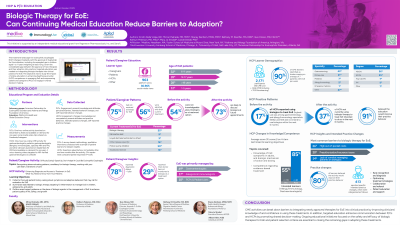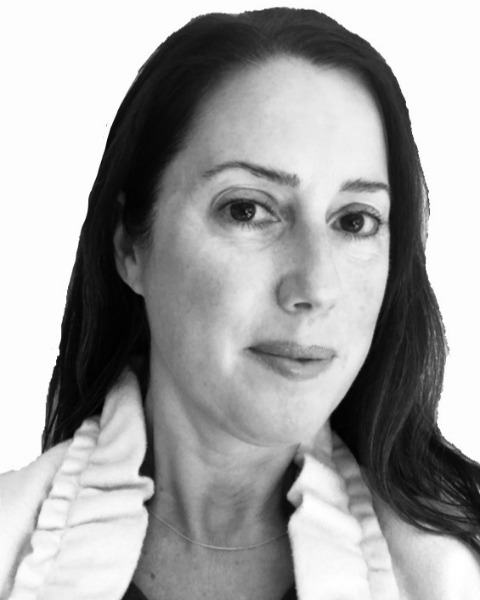Sunday Poster Session
Category: Esophagus
P0519 - Biologic Therapy for EoE: Can Continuing Medical Education Reduce Barriers to Adoption?
Sunday, October 27, 2024
3:30 PM - 7:00 PM ET
Location: Exhibit Hall E

Has Audio

Kristin Della Volpe, BA
Medlive
Needham, MA
Presenting Author(s)
Kristin Della Volpe, BA1, Mirna Chehade, MD, MPH2, Stacey Denham, MPH3, Bethany Doerfler, MS, RDN4, Ikuo Hirano, MD, FACG5, Kathryn Peterson, MD, MSci6, Mary J. Strobel, 7, Carole Drexel, PhD1
1Medlive, Needham, MA; 2Icahn School of Medicine at Mount Sinai, New York, NY; 3Asthma and Allergy Foundation of America, Arlington, VA; 4Feinberg School of Medicine, Northwestern University, Chicago, IL; 5Kenneth C. Griffin Esophageal Center, Northwestern University Feinberg School of Medicine, Chicago, IL; 6University of Utah Health, Salt Lake City, UT; 7American Partnership for Eosinophilic Disorders (APFED), Atlanta, GA
Introduction: The treatment landscape for eosinophilic esophagitis (EoE) changed markedly with the recent approval of dupilumab for this indication. Given the considerable gap between newly approved therapies and adoption into practice, targeted education on integrating biologic therapies into clinical practice for EoE is essential. The objective of this study is to examine the impact of online education for healthcare providers (HCPs) and patients/caregivers (P/Cs) in enhancing HCPs’ competence in managing EoE with biologics and empowering patients to participate in shared decision-making.
Methods: One 60-min CME session and one 60-min P/C education session were launched live online on 7/27/23 and made available on-demand for 1 year. Knowledge, attitude, and practice-pattern questions were administered before and immediately after the activity (pre vs post). Chi-square tests compared paired responses (P < 0.05; pre/post).
Results: As of 5/10/2024, 1192 HCPs had participated in the live/on-demand activity. A total of 862 people engaged in the P/C activity.
Overall, 17% of HCPs reported using biologics to treat EoE at the time of the activity, with 56% of gastroenterology and allergy/immunology specialists (n = 55) reporting use. The most common HCP-reported barriers to biologic therapy for EoE were patient doubts about the efficacy and/or safety of biologics (48%) and preauthorization/insurance issues (42%).
Prior to the activity, 54% of P/Cs reported they were not knowledgeable about biologics as a treatment option and 77% had not received a biologic therapy for EoE. Nearly half of P/Cs (46%) were not satisfied with their current EoE treatment regimen.
After the activity, 37% of HCPs who did not currently use biologic therapy to treat EoE intended to do so in the next 6 months and 91% believed this activity would improve their practice behavior. Also, 67% of P/Cs said they were likely to discuss biologic therapy at future appointment visits.
Discussion: CME activities can break down barriers to adoption of newly approved therapies for EoE by enhancing clinicians’ knowledge of and comfort in using these agents. Further, education improves communication between P/Cs and HCPs by encouraging shared decision-making. Future education on the safety and efficacy of biologic therapy for EoE and the selection of patients who may benefit from this therapy can address the remaining gaps in adoption.
Disclosures:
Kristin Della Volpe, BA1, Mirna Chehade, MD, MPH2, Stacey Denham, MPH3, Bethany Doerfler, MS, RDN4, Ikuo Hirano, MD, FACG5, Kathryn Peterson, MD, MSci6, Mary J. Strobel, 7, Carole Drexel, PhD1. P0519 - Biologic Therapy for EoE: Can Continuing Medical Education Reduce Barriers to Adoption?, ACG 2024 Annual Scientific Meeting Abstracts. Philadelphia, PA: American College of Gastroenterology.
1Medlive, Needham, MA; 2Icahn School of Medicine at Mount Sinai, New York, NY; 3Asthma and Allergy Foundation of America, Arlington, VA; 4Feinberg School of Medicine, Northwestern University, Chicago, IL; 5Kenneth C. Griffin Esophageal Center, Northwestern University Feinberg School of Medicine, Chicago, IL; 6University of Utah Health, Salt Lake City, UT; 7American Partnership for Eosinophilic Disorders (APFED), Atlanta, GA
Introduction: The treatment landscape for eosinophilic esophagitis (EoE) changed markedly with the recent approval of dupilumab for this indication. Given the considerable gap between newly approved therapies and adoption into practice, targeted education on integrating biologic therapies into clinical practice for EoE is essential. The objective of this study is to examine the impact of online education for healthcare providers (HCPs) and patients/caregivers (P/Cs) in enhancing HCPs’ competence in managing EoE with biologics and empowering patients to participate in shared decision-making.
Methods: One 60-min CME session and one 60-min P/C education session were launched live online on 7/27/23 and made available on-demand for 1 year. Knowledge, attitude, and practice-pattern questions were administered before and immediately after the activity (pre vs post). Chi-square tests compared paired responses (P < 0.05; pre/post).
Results: As of 5/10/2024, 1192 HCPs had participated in the live/on-demand activity. A total of 862 people engaged in the P/C activity.
Overall, 17% of HCPs reported using biologics to treat EoE at the time of the activity, with 56% of gastroenterology and allergy/immunology specialists (n = 55) reporting use. The most common HCP-reported barriers to biologic therapy for EoE were patient doubts about the efficacy and/or safety of biologics (48%) and preauthorization/insurance issues (42%).
Prior to the activity, 54% of P/Cs reported they were not knowledgeable about biologics as a treatment option and 77% had not received a biologic therapy for EoE. Nearly half of P/Cs (46%) were not satisfied with their current EoE treatment regimen.
After the activity, 37% of HCPs who did not currently use biologic therapy to treat EoE intended to do so in the next 6 months and 91% believed this activity would improve their practice behavior. Also, 67% of P/Cs said they were likely to discuss biologic therapy at future appointment visits.
Discussion: CME activities can break down barriers to adoption of newly approved therapies for EoE by enhancing clinicians’ knowledge of and comfort in using these agents. Further, education improves communication between P/Cs and HCPs by encouraging shared decision-making. Future education on the safety and efficacy of biologic therapy for EoE and the selection of patients who may benefit from this therapy can address the remaining gaps in adoption.
Disclosures:
Kristin Della Volpe indicated no relevant financial relationships.
Mirna Chehade: Adare/Ellodi – Consultant, Grant/Research Support. Allakos – Consultant, Grant/Research Support. AstraZeneca – Consultant, Grant/Research Support. Bristol Myers Squibb – Consultant, Grant/Research Support. Danone – Grant/Research Support. Nexstone Immunology – Consultant. Phathom – Consultant. Recludix Pharma – Consultant. Regeneron Pharmaceuticals Inc. – Consultant, Grant/Research Support. Sanofi – Consultant. Shire/Takeda – Consultant, Grant/Research Support.
Stacey Denham indicated no relevant financial relationships.
Bethany Doerfler indicated no relevant financial relationships.
Ikuo Hirano: Adare/Ellodi – Consultant, Grant/Research Support. Allakos – Consultant, Grant/Research Support. Aslan – Consultant. AstraZeneca – Consultant, Grant/Research Support. Calyx/Parexel – Consultant. Celldex Therapeutics – Consultant. Eli Lilly – Consultant. Ellodi/Adare Pharma Solutions – Consultant. EsoCap – Consultant. Gossamer Bio – Consultant. Meritage – Consultant, Grant/Research Support. Nexstone Immunology – Consultant. Pfizer/Arena Pharmaceuticals – Consultant, Grant/Research Support. Phathom – Consultant. Phathom Pharmaceuticals – Speakers Bureau. Receptos/Celgene/BMS – Consultant, Grant/Research Support. Regeneron Pharmaceuticals Inc. – Consultant, Grant/Research Support, Speakers Bureau. Sanofi – Consultant, Speakers Bureau. Shire/Takeda – Consultant, Grant/Research Support.
Kathryn Peterson: Adare – Grant/Research Support. Alladapt – Consultant, Honoraria. Allakos – Consultant, Grant/Research Support, Honoraria, Speakers Bureau. AstraZeneca – Consultant, Grant/Research Support, Honoraria. Bristol Myers Squibb – Consultant, Honoraria. Celldex – Grant/Research Support. Chobani – Grant/Research Support. Ellodi – Consultant, Grant/Research Support, Honoraria. Invea – Consultant, Honoraria. Lucid – Consultant, Honoraria. NexEos Bio – Stock Options. Nexstone – Consultant, Honoraria. Regeneron – Consultant, Speakers Bureau. Regeneron-Sanofi – Grant/Research Support. Revolo – Grant/Research Support. Takeda – Consultant, Honoraria, Speakers Bureau.
Mary Strobel indicated no relevant financial relationships.
Carole Drexel indicated no relevant financial relationships.
Kristin Della Volpe, BA1, Mirna Chehade, MD, MPH2, Stacey Denham, MPH3, Bethany Doerfler, MS, RDN4, Ikuo Hirano, MD, FACG5, Kathryn Peterson, MD, MSci6, Mary J. Strobel, 7, Carole Drexel, PhD1. P0519 - Biologic Therapy for EoE: Can Continuing Medical Education Reduce Barriers to Adoption?, ACG 2024 Annual Scientific Meeting Abstracts. Philadelphia, PA: American College of Gastroenterology.
